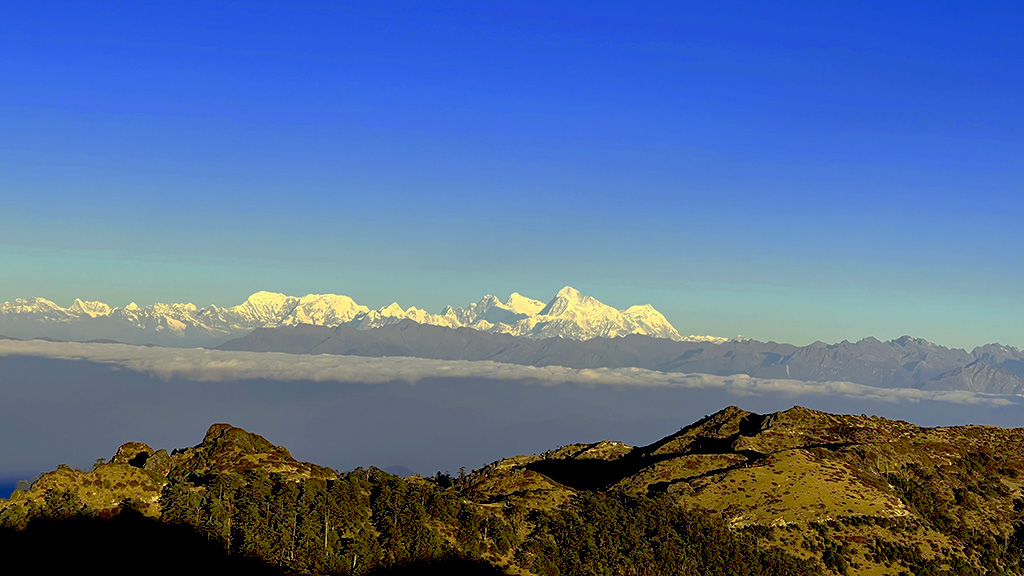
Master Shifu, the headmaster of the Jade Palace, the Furious Five’s strict instructor, and Po’s mentor, is probably still fresh in your mind from the Kungu Panda film. Master Shifu is a red panda; an adorable, furry little mammal featured in many Himalayan folklores. Because the giant panda is a bear, it stands to reason that the red panda, not the “Gaint Panda,” is the true panda.
The Red Panda is a cute little creature three to four times the size of a furry Persian cat found only in Asia’s Himalayan region. Scientists earlier believed that it was a small panda from the bear family. However, DNA studies have recently revealed that red pandas are more closely related to racoons than bears.
How to locate a Red Panda in the Himalayan region In India?
The red panda lives in elevated and isolated areas of the Himalayan region. The mammal is known for blending in quietly with its surroundings. Hence seeing and photographing them in the wild is an arduous task for photographers and nature lovers. Even though many national parks in Nepal, India, Bhutan, and China are highly protected sanctuaries for them, poaching, habitat destruction, and other factors have reduced their population in the wild. Because it is estimated that only less than 10000 red pandas remain in the wild and the population is still declining, the United Nations has listed the red panda as “endangered.”.
Red Panda Expedition: Is this an act of animal cruelty?
Red Pada photography tours are among the most difficult Himalayan wildlife expeditions and snow leopard expeditions. Nonetheless, it is now a thriving tourism activity in Nepal and India. However, I have yet to obtain any data on red panda-related tourism in China. I’ve also seen numerous social media and website advertisements promoting red panda tours in the Chinese provinces of Yunnan and Sichuan. With the advent of the Red panda tourism industry, many porches have been converted into panda tour guides and trackers, and the predictors have now become its guardian angels. But is panda tourism straining the peaceful lives of wild pandas? Should panda expeditions be regulated and limited in scope? Yes, I believe so!
Tracking down a Rad Panda - A stressful exercise
Trackers leave the camp early in the morning, while guests remain at camp with the guide. They usually travel in small groups of three to five people. Trackers search the slopes covered in rhododendrons and bamboo forests for the presence of red pandas. When they spot a panda resting on a tree, they circle it and stand guarding it to keep the panda from leaving. Pandas cannot jump from one tree to another and must first come to the ground before proceeding to the next.
While the trackers guard around the tree, one member calls the guide on mobile or returns to the camp to deliver the news. The guide then takes the guests to the locations and shows them the animal in its natural environment. Sometimes, this process can take a few hours, especially if the spotting occurs far from the camp and the terrain is too steep to climb. The poor animal will be kept captive on the tree until the “humans” arrive, take photos, and celebrate the rare sighting.
Singalila National Park and Red Panda Expeditions
The Singalila national park, which spans over India and Nepal, is likely the best place to see red pandas in the wild. The Indian side of the park is predominantly located in the Darjeeling district (the district capital is also called Darjeeling). The park has elevations ranging from 7400ft to 12000 ft and is popular among bikers and trekkers in addition to its birds and wildlife.
How can you reach Singalila National Park in India?
The Bagdogra airport (IXB) in Siliguri, West Bengal, is the nearest and most convenient airport. You can also arrive in Siliguri by overnight train from Kolkatta. A road trip to Singalila national park from the Bagdogra airport can take 5-6 hrs, depending upon the road and weather conditions. The first task is to drive up to the Maneybhanjang (7054 feet) through picturesque valleys and ridges, which is beautiful and relatively easy. But here, you must change to a local 4X4 taxi with park permits.
Please ensure you reach here before 2 PM as the park authorities will only allow vehicles to the park after this time. You also require to take a park permit to enter. It can be done through your tour guide.
Land Rovers of Maneybhanjang: A moving British heritage of the Himalayas
The most appealing aspect of this small, charming village at the base of the Singaila National Park is its pride, grand old Land Rover vehicles in service here. Land Rovers arrived in the Himalayas in the 1930s-40s to be used in English tea plantations, and they did not leave these mountains along with the British when India gained independence. They still stand as great relics of a bygone era, and the villagers are extremely proud of them.
My driver informed me that 40 of them are still in service, and the majority are at least 60 years old. You must definitely consider hiring a land rover for your park expeditions.
Tumlings (India) and Kayyakatta (India-Nepal border) are prominent locations where red pandas can be found relatively easily. I chose Kayyakkatta because it allows me to explore the Nepalese side of the national park, where I have a better chance of seeing a red panda (Permission required). It is approximately 5 kilometres from Gairibas. I stayed at a homestay in Gairibas and drove up to Kayyakatta every day (I was there for four nights) to look for birds and red pandas.
As I mentioned in the blog, locating red pandas is the job of local trackers, who are excellent at it. We missed the panda on the first two days, but on the third day, after a 4 km walk and crawling up a bamboo mountain (an arduous trek), we had a great sighting of a male panda on eye level. A once-in-a-lifetime sighting will live on in my memory for a long time. Thanks to our trackers, who had taken a lot of effort to locate the red panda for us.
Himalayan Wildlife Expedition guides
The quality of the guide you work with will determine your success in a red panda expedition. A good guide will have a strong network of local trekkers, increasing the chances of locating a panda. You must ensure that he can communicate with you in English (if you do not speak Hindi or Bengali) and that he can arrange bearable accommodations. Before selecting an accommodation, please specifically ask for details of hot water, heating and toilet facilities and make sure it’s available and in good condition. We engaged www.planetasiaexpeditions.com for our tour.
Accommodations in Singalila National Park In India
The quality of lodging available here can be the most disappointing and unbearable aspect of the entire expedition. The best time to see red pandas are from October to December and from March to the beginning of May. If you’re a birder, I suggest you visit the park in April as then you are likely to see many rare and sought-after birds at that time. The temperatures can range from 12 degrees Celsius to 1 degree during these times, and finding a warm place to stay is critical for most of us in such weather conditions.
First and foremost, no accommodation in the mountains provides a heating system. The toilets are leaking and generally in disrepair in most homestays. If you are not used to staying in such conditions, you must consult your guide ahead of time and ensure that you fully understand what to expect. Alternatively, you can find comfortable accommodations near Darjeeling and travel daily to Tumlings or Kayyakkatta (2-3 hours).

Another recommended nearby destination is Sandakphu. It is almost a two-hour drive from Gairibas. You will get a fantastic view of many Himalayan peaks, including mount Everest.
Ready? Singalila is calling for you! Your moment is waiting!


